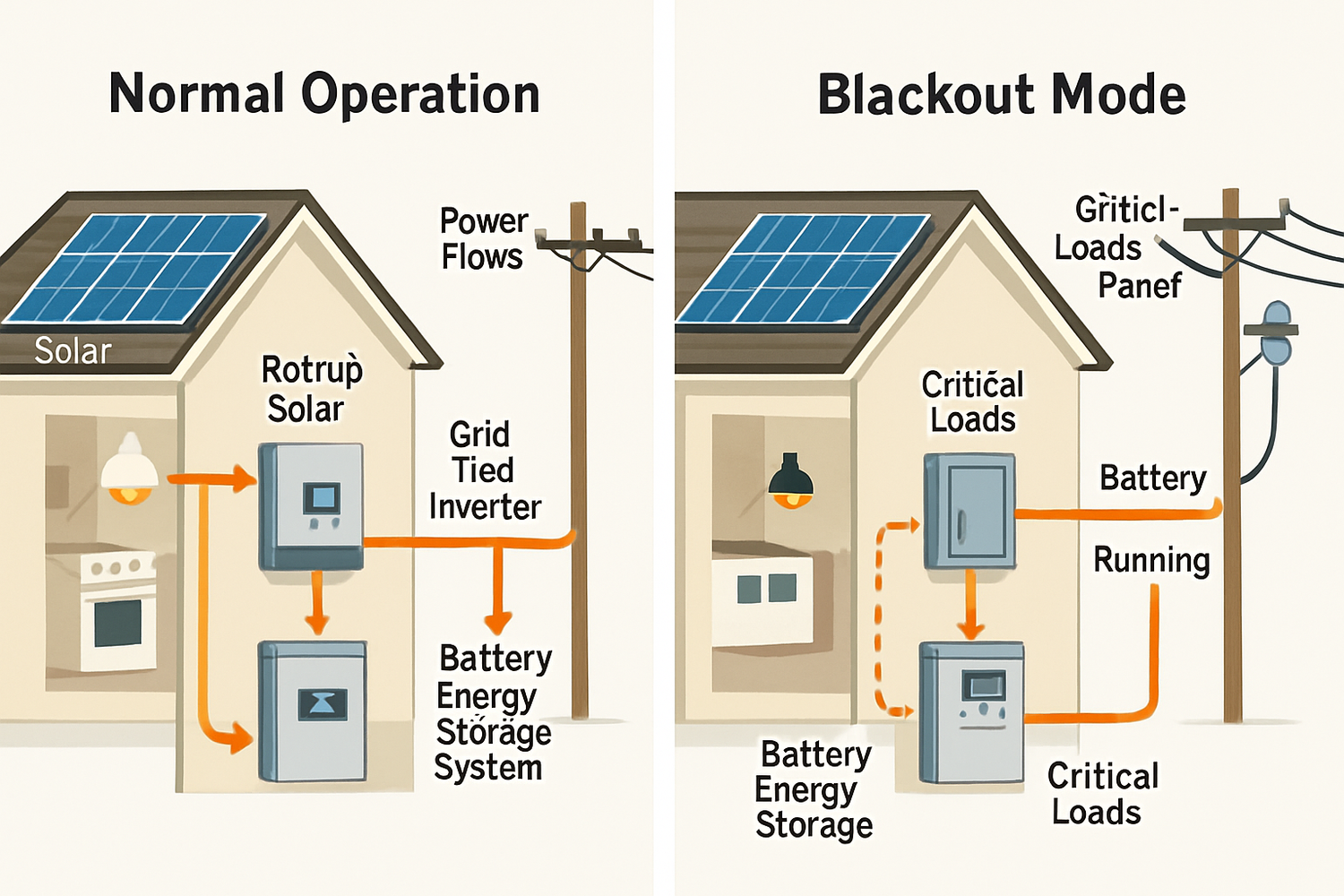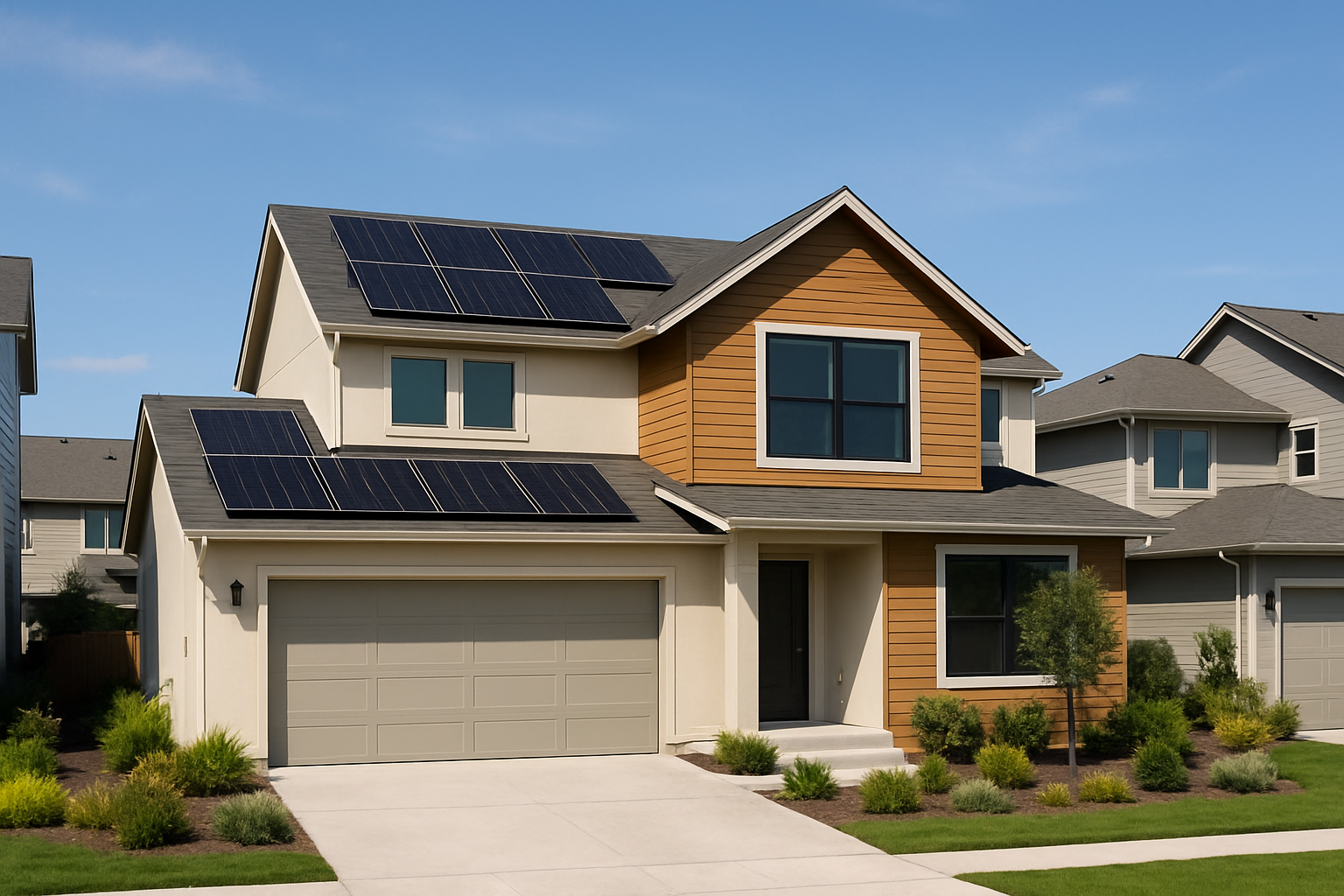Grid-tied solar panels stop sending power during a blackout. This is not a fault. It is a required safety feature called anti-islanding. You gain safer streets, protected utility crews, and stable equipment. You also get a clear path to reliable backup if you add the right storage and controls.

What actually happens during a blackout
During normal grid service, your inverter synchronizes with the grid. It matches voltage and frequency and exports solar power. During a blackout, the inverter detects abnormal grid conditions. It disconnects within seconds and stops exporting. Your panels still produce DC, but the inverter blocks output to the grid and to your home circuits unless you have an islanding-capable system.
This behavior protects lineworkers from backfeed and prevents uncontrolled islands. The U.S. Department of Energy notes that safe interconnection requires inverters to disconnect if grid voltage or frequency moves outside allowed windows, which includes outages and faults. According to U.S. Department of Energy, modern PV systems follow grid codes and anti-islanding practices to maintain safety and reliability.
Both string inverters and microinverters follow these rules. The exact trip limits depend on local grid codes and utility agreements. You will see similar behavior across regions, guided by standards that set voltage, frequency, and timing thresholds.
Anti-islanding in plain terms
Islanding is a condition where a local section of the grid stays energized by distributed generation after the utility supply is gone. Anti-islanding is the set of methods that inverters use to avoid this. They either detect loss of grid and trip fast, or they actively push the system away from steady operation so any island collapses and trips.
How inverters detect a blackout
- Voltage window: If voltage falls too low or rises too high, the inverter opens its relay.
- Frequency window: If frequency drifts outside a narrow band, the inverter shuts down.
- Rate of change of frequency (ROCOF): A rapid swing signals grid loss.
- Active perturbation: The inverter injects small signals. If the grid is gone, these signals move voltage or frequency enough to trigger a trip.
The International Energy Agency highlights the rapid growth of distributed PV and the need for smart inverters to support grid safety and stability. See IEA Solar PV for global trends and integration topics.
Typical protection actions
The values vary by region and utility. The pattern is consistent: detect, disconnect, and stay offline until the grid is stable for a reconnection time.
| Detection method | Signals used | Typical action | Notes |
|---|---|---|---|
| Voltage window | RMS voltage outside allowed band | Trip in fractions of a second to a few seconds | Protects devices from under/overvoltage |
| Frequency window | Hz outside narrow band | Trip fast; reconnection after stable period | Prevents desynchronization and motor damage |
| ROCOF | Fast frequency change | Immediate trip | Good for rapid island events |
| Active anti-islanding | Injected perturbations | Forces instability in a potential island | Improves detection in light-load cases |
Why safety shutoff is non‑negotiable
Lineworker and public safety
Backfeed can energize lines that crews expect to be dead. A single rooftop array could keep a small section live and create a shock hazard. Shutoff removes that risk. The EIA explains that PV systems use inverters to convert DC to AC tied to the grid’s parameters, and that safe operation depends on protective devices and rules. See EIA: Photovoltaics and electricity.
Grid and equipment protection
Uncontrolled islands can drive unstable voltage and frequency. Motors, HVAC systems, and electronics can suffer damage. Inverters must trip to avoid cascading issues. IEA materials emphasize that standards and smart inverter functions support secure, resilient operation as PV penetration rises. See IEA Solar PV.
Compliance and interconnection
Utilities require anti-islanding for interconnection approval. Inspections confirm that inverters meet codes, and that relays open on grid loss. The U.S. Department of Energy notes that smart inverter features and interconnection practices are part of safe solar deployment. See DOE: Solar Energy.
How to keep power during outages
You can keep critical loads on during a blackout with battery storage and an islanding-capable hybrid inverter. This setup forms a local microgrid in your home. It supplies a dedicated “critical loads” subpanel and isolates from the utility line.
Option overview
| Configuration | Outage behavior | Main components | Typical use case |
|---|---|---|---|
| Grid-tied PV only | Shuts off during blackouts | PV array + grid-tied inverter | Lower upfront cost, no backup need |
| PV + Battery (Hybrid ESS) | Keeps critical loads powered; anti-islands from grid | PV array + hybrid inverter + LiFePO4 battery + transfer device + critical loads panel | Homes that need quiet, automatic backup |
| Off-grid solar | Always islanded; grid not required | PV array + off-grid inverter/charger + battery + generator (optional) | Remote homes, cabins, farms |
Core hardware for outage-ready solar
- Lithium iron phosphate (LiFePO4) batteries: High cycle life, stable chemistry, broad operating window.
- Hybrid solar inverter: Converts DC to AC, manages battery charging, and forms a local AC grid during outages.
- Energy storage system (ESS): An integrated package with battery, inverter, and monitoring, matched to your array.
- Transfer device and critical loads panel: Isolates your home from the grid and feeds selected circuits.
IRENA tracks rapid growth in battery storage as a key flexibility tool, helping PV support reliability during both normal operation and outages. See IRENA for energy storage insights.
Sizing tips that actually work
Start with your critical loads. List the circuits you need during an outage: refrigerator, lighting, internet, some outlets, and possibly a small heat pump or well pump.
- Peak power: Add up running watts and check surge. A 1.5-ton heat pump may need 3–5 kW surge for a few seconds. Choose an inverter with headroom.
- Energy (kWh): Estimate how long you want backup. Example: 500 W average critical load for 8 hours needs about 4 kWh. Add 15–25% for losses and weather margin. A 5–6 kWh battery can cover that case.
- Solar array size: Aim to recharge the battery in 1–2 good sun days. If daily critical use is 6 kWh and local peak sun hours are 4–5, a 1.5–2 kW array dedicated to recharge can work. Many homes already have 5–10 kW arrays, which helps recovery after storms.
The EIA notes that PV generation depends on irradiance and system design, and that inverters are central to AC supply. See EIA: Photovoltaics and electricity.
What to expect during and after an outage
Automatic transfer and ride-through
In a hybrid system, the inverter detects grid loss and opens a transfer mechanism. It powers the critical loads panel from the battery and PV. You may feel a brief blink while it switches. If the sun is up, PV will support the battery and loads. At night, you run on stored energy.
Reconnection to the grid
After utility service stabilizes, the inverter waits a short reconnection period. It then resynchronizes and resumes normal operation. This delay prevents nuisance toggling and aligns with grid rules.
Generator integration
For long outages, a small generator can extend autonomy. Many inverters support generator input and manage charging to avoid overloading. Coordinate settings so the inverter and generator share loads without nuisance trips.
Common myths, cleared up
- “My panels will run my home during a blackout.” Not unless your system has battery storage and an islanding-capable inverter.
- “Batteries waste solar energy.” Storage keeps power local for outages and peak shaving. With smart controls, you still export surplus.
- “Off-grid is always better.” Off-grid fits remote sites. In cities and suburbs, hybrid ESS gives you backup while keeping grid benefits.
The IEA and DOE emphasize that PV plus flexibility resources improves both reliability and emissions reduction. See IEA Solar PV and DOE: Solar Energy.
Practical checklist for outage-ready solar
- Select safe chemistry: LiFePO4 batteries offer stable performance and robust cycle life.
- Use a hybrid inverter with certified anti-islanding and grid support functions.
- Add a critical loads panel: Separate must-have circuits for longer runtimes.
- Plan autonomy: Size battery for overnight needs; size PV to recover charge within 1–2 days of sun.
- Include rapid shutdown and labeling per local code.
- Test backup mode at least quarterly. Update firmware as recommended.
- Coordinate with your utility on interconnection and settings.
How our focus aligns with outage protection
We build lithium batteries based on LiFePO4 chemistry, home ESS that integrate batteries, hybrid inverters, and solar panels, off-grid solar packages, and solar inverters. The goal is simple: reliable and scalable energy. For homes that need outage protection, a compact ESS can power critical circuits quietly and automatically. For remote cabins or farms, off-grid solutions pair storage with a robust inverter/charger and optional generator support. You gain energy independence while staying within safety and interconnection rules.
Key takeaways
- Solar panels do not keep exporting during a blackout. Anti-islanding shuts inverters off to protect people and equipment.
- A hybrid system with battery storage maintains power to critical loads and isolates from the grid safely.
- Right-sizing the battery, inverter, and array gives you practical, quiet backup for hours to days.
- Standards, smart inverters, and storage scale with rising PV adoption, as noted by IEA, DOE, EIA, and IRENA.





Leave a comment
All comments are moderated before being published.
This site is protected by hCaptcha and the hCaptcha Privacy Policy and Terms of Service apply.